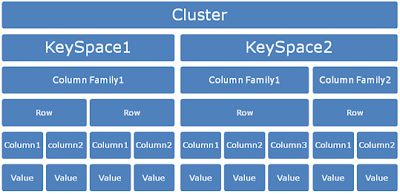In continuation to my
previous blog, this blog will explore the Key-Value Store working methods and its
relevance with Cassandra.
Before we enter into the
practical aspects of Key-Value pairs we might need to come across some
technical terms with respect to Cassandra such as KeySpace, Column Family,
etc., We will just go across for short time and will jump on to exploring
key-value pairs concept in Cassandra.
Cassandra Key Space and Column Families:
If we have database in an RDBMS system the equivalent in Cassandra is
Keyspace.
Similar to the way a database contains a group of tables; a Keyspace
contains a group of Column Families or its logical namespace for a group of
column families. That brings us to a
new term Column families. One keyspace can have one or more column families.
What are exactly column families?
When we say keyspace analogous with Database, Column
families are analogous to tables. Column family is set of
columns. In Cassandra each column family is stored in a separate file which is
sorted in a row. This is a container for collection of rows. The row key determines in which machine the
data is stored.
Executing commands in Cassandra CLI:
Please note that in Cassandra
all the commands will get executed only if its terminated with “;”. Pressing a return or enter key
without Semicolon will expect more inputs from the end user in the CLI (Command
Line Interface)
We will see practical aspects of using the same in Cassandra in my next blog.
We will see practical aspects of using the same in Cassandra in my next blog.

1 comment:
Rs.150 charge for withdrawal http://valavan-teentonic.blogspot.com/2017/03/rs150-charge-for-withdrawal.html
Post a Comment